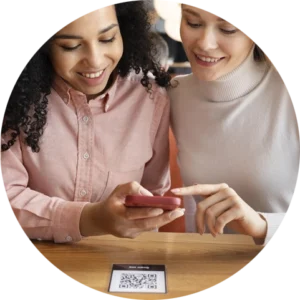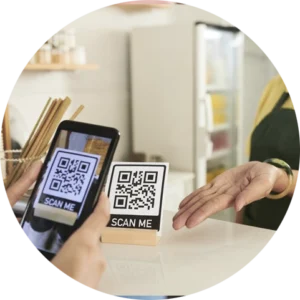QR Code Payments
Embrace the speed and security of QR payments.
QR (Quick Response) codes were created in 1994 by a Japanese company, Denso Wave. Since then, they’ve been used in many contexts, including marketing, information sharing, shipment tracking, quality control, and, of course, mobile payments.
How QR Code Purchases Work
Every part of the QR code contains several information layers that get put together in the right order once it’s scanned through a compatible application. The square markings in the corners signal the app what the correct orientation of the code is so that the consumers could scan it from any angle. Unlike barcodes, QR codes can be read not only from paper but also from a screen.


1. The consumer scans a merchant’s QR code.
When a customer scans the code with their device’s camera or a compatible app, a link pop up. The shopper then has to click it to be redirected to a web payment form where they can choose a preferred payment method.
2. The merchant uses a customer’s QR code
It’s also possible for a merchant to scan a QR code from the client’s device without any special equipment - a smartphone is enough. This code is generated by the consumer’s bank or payment app and contains their encrypted card details.


3. An app-to-app payment
Both the customer and the merchant have to open their apps. The client then scans the unique QR code that is generated in the seller’s application and confirms the amount to be paid.
QR code payments offer plenty of benefits for both merchants and customers.
Convenience
A QR code can be placed virtually anywhere: outside a store, on the website, in a social media post, or in an email. This means that the clients can conduct purchases conveniently wherever they prefer.
Simple Setup
QR codes eliminate the need for bank cards and payment terminals. A merchant only needs a mobile device to start accepting payments.
Affordability
Such payments are extremely cost-effective and come with smaller transaction charges. Besides, merchants don’t need to purchase any additional hardware to facilitate QR code transactions.
Top-notch Security
Did you know that QR codes are among the most secure payment methods? This is due to the fact that all sensitive information is encrypted, and no customer details are stored on file.
High Accessibility
Any person who has a mobile device and a banking app can easily conduct QR code payments
Faster Transactions
The processing of a QR code payment typically takes no longer than three seconds, which has a positive influence on the user experience.
